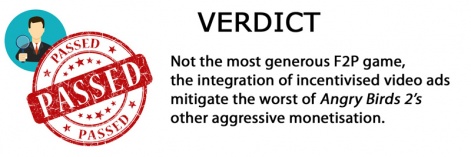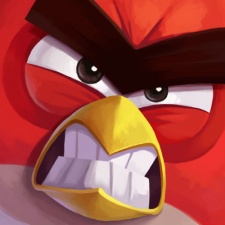Welcome back to the In-App Purchase Inspector - our regular look at free-to-play games from the consumer's perspective.
In each instalment, we consider the incentives or pressure applied to make in-app purchases, their perceived value, the expansion offered by IAPs and the overall value of the experience.
The end goal is to see whether the game makes a good enough case for us to part with our cash, or whether players are content - or engaged enough - to 'freeload'.
This time, we're taking a look at Rovio's long-awaited sequel Angry Birds 2, to see how its adoption of the freemium model has affected the core bird-lobbing experience.
Free bird
Angry Birds 2 makes for an interesting case study, as - for the most part, at least - when we see free-to-play games they are built with the monetisation in mind.
There's no cynical element implied here, simply that there's often a certain compatibility between business model and game design that clearly marks something out as a free-to-play title.
The obvious example of this is the incredibly popular mobile strategy genre, whose reliance on long-term, iterative base-building and defence lends itself perfectly to microtransactions and wait timers.
Think of Siegefall or Rival Kingdoms, for example. Take away the microtransactions, slap a price-tag on them, and you've got a completely different game.
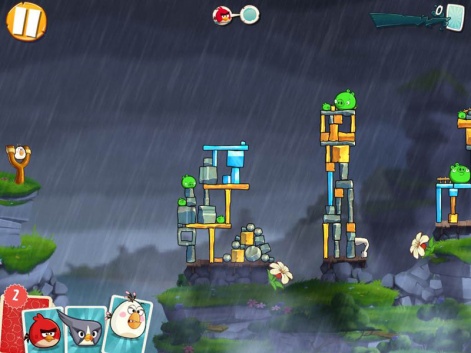
What makes Angry Birds 2 so interesting, then, is that it effectively takes the (still fun) flick-birds-at-wobbly-structures formula of the 2009 original, but switches from premium to free-to-play.
The game monetises in all the ways you'd expect of a freemium Angry Birds experience.
And so, for many who remember paying up-front for the original in the early years of mobile gaming, the changes made to facilitate the now-standard free-to-play model will rub them up the wrong way.
But, judged on its own terms, how does the monetisation of Angry Birds 2 perform when compared against the mature free-to-play landscape of 2015, rather than a slightly unfair comparison to its 2009 predecessor?
Magpie
The game essentially monetises in all the ways you'd expect of a freemium Angry Birds experience.
There's a new hard currency - in the form of gems, as standard - which is used for continues, buying powerups, and to bypass the game's energy system.
You only get a handful of gems to start out, and aside from daily rewards (the value of which can be doubled by watching a video ad) they're not really doled out as freebies.
Gem packs range from $0.99 for 80 to $49.99 for 5700, although occasionally you're offered tempting, time-limited discounts such as the 'Early Bird Offer', which doubles your $0.99 gem yield to 160 and rewards you with some exclusive in-game trinkets.
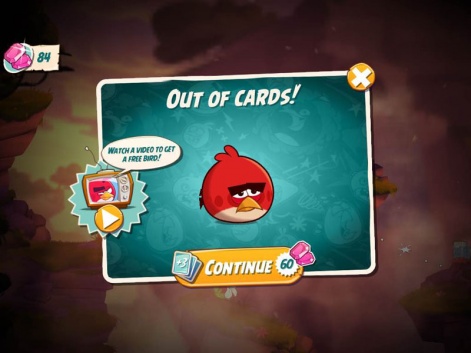
This, like many similar offers waved in front of the player in the early stages of free-to-play games, aims to get you in the habit of spending right off the bat, ensuring good value and thus partially dismantling the psychological barrier to future in-game transactions.
To continue a failed stage, replenishing all your birds mid-level, it costs 60 gems - amounting to approximately $0.74 in real money.
How far do these gems go, though? To continue a failed stage, replenishing all your birds mid-level, it costs 60 gems. If you purchase a bundle at $0.99, this single transaction then accounts for three-quarters of the 80 gems you paid for - amounting to approximately $0.74 in real money.
That's actually quite a lot, especially as it's often very hard to complete the new levels (which now take place over multiple screens) in one go.
I opted for the 560 at $7.49 bundle, and found my hoard depleting quite rapidly through what I felt was standard, by no means intense play.
Vulture
Herein lies a problem. Angry Birds always felt like it was cheating you out of something at times - those damned pigs! - but the stakes are raised when you elicit this feeling in the free-to-play realm.
You can't help but feel that this difficulty, despite being true to the spirit of the series, is more harshly engineered against you now that Rovio has a vested interest in making you fail.
Also, while I'm usually the last person to lobby the oft-misused accusation of 'pay-to-win', Angry Birds 2 offers a series of extremely powerful consumable spells - from a shower of rubber ducks (!) to a chilli pepper that sets stages aflame - that almost always trigger victories and come at 20 to 30 gems apiece.
Perhaps that's cynical of me, or unfair, but the fact remains that these are the creeping doubts developers risk causing when transitioning from premium to free-to-play.
Regardless, by anyone's standards the prices are steep. Frustrating, too, is the game's energy system, in which one of five lives depletes every time you fail a stage.
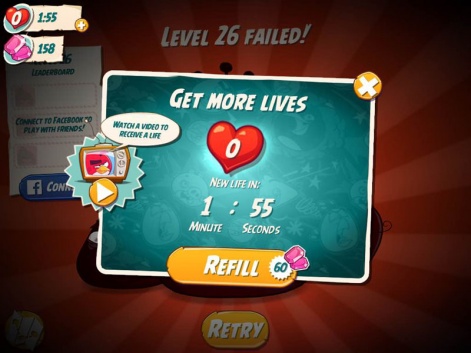
Each life takes 10 minutes to regenerate, meaning that if you fail five times in a row (not unlikely in some of the tougher stages, especially if you're determined not to pay) you'll be waiting 50 minutes before you regain your full quota.
It costs 60 gems to completely restore your lives, or you can watch a video ad to receive one for free.
No fowl play
It's here that Angry Birds 2 redeems itself.
The incentivised ads don't allow you to ignore the in-app purchases altogether, as they're limited in function - only restoring a single life, and reviving only a single bird rather than your whole flock should you fail a level.
However, while it could be seen as just another prong in Rovio's move towards full-on F2P, incentivised video ads make the player much more likely to be able to muddle through without spending money, or at least to strike a more satisfactory balance between spending and freeloading.
